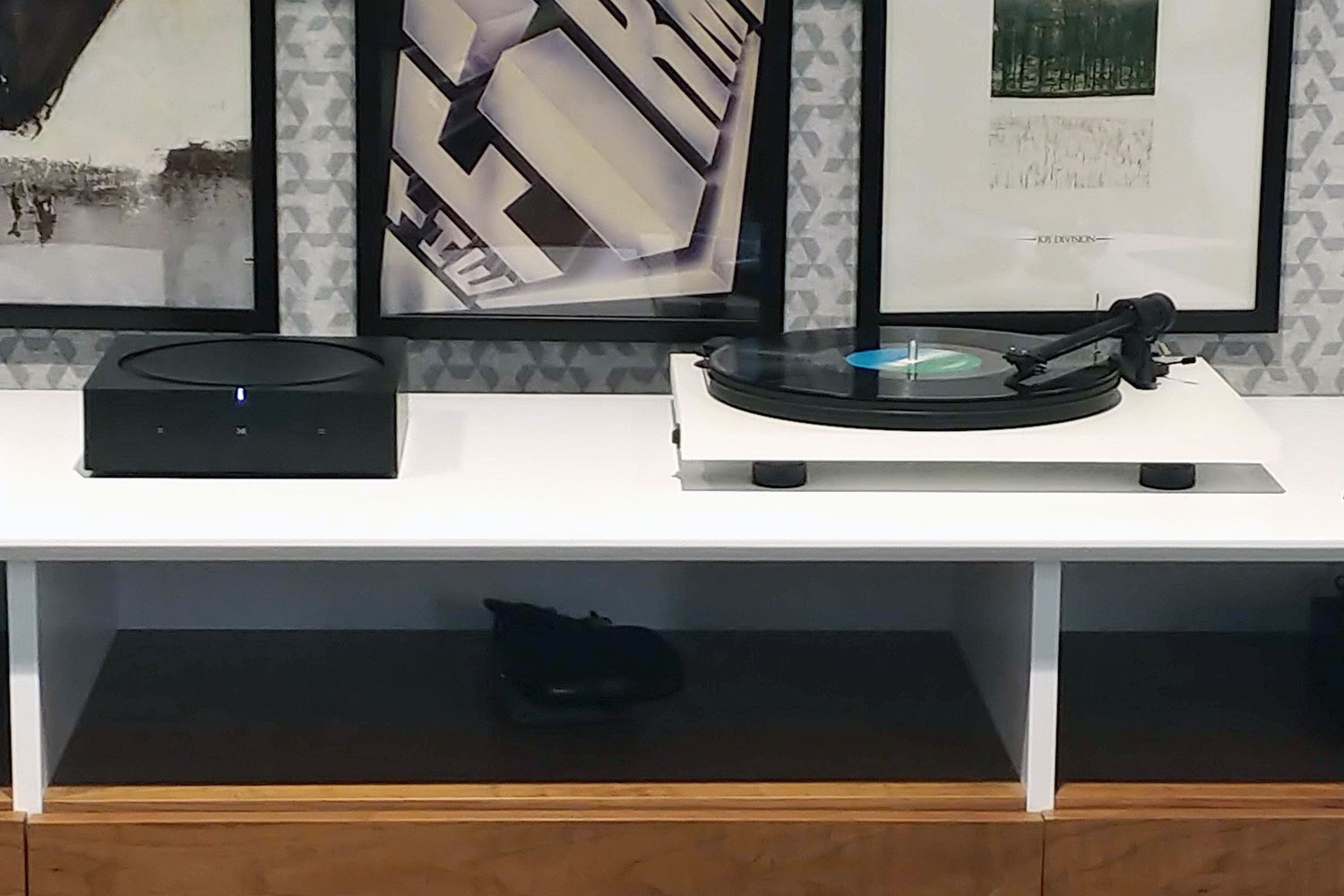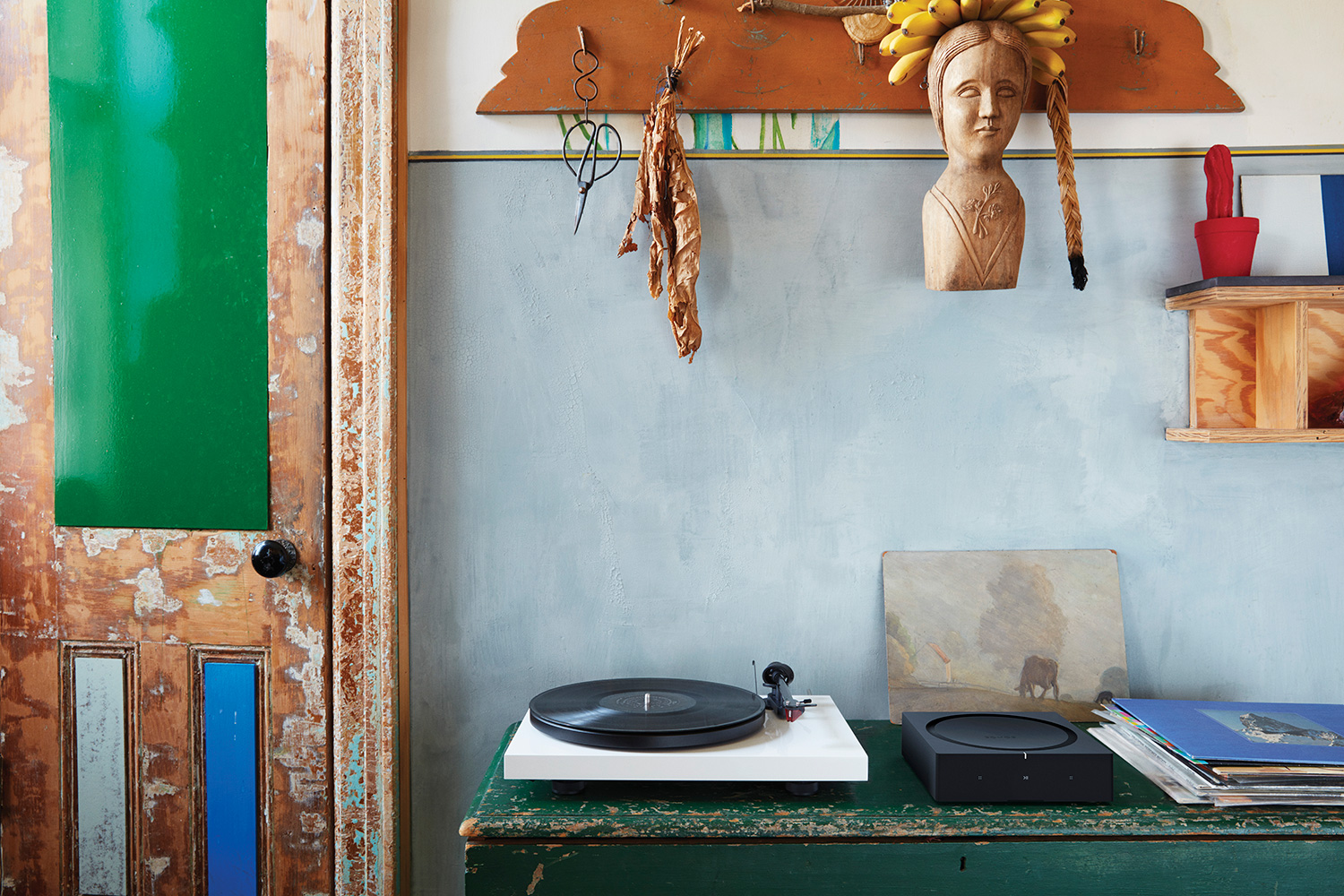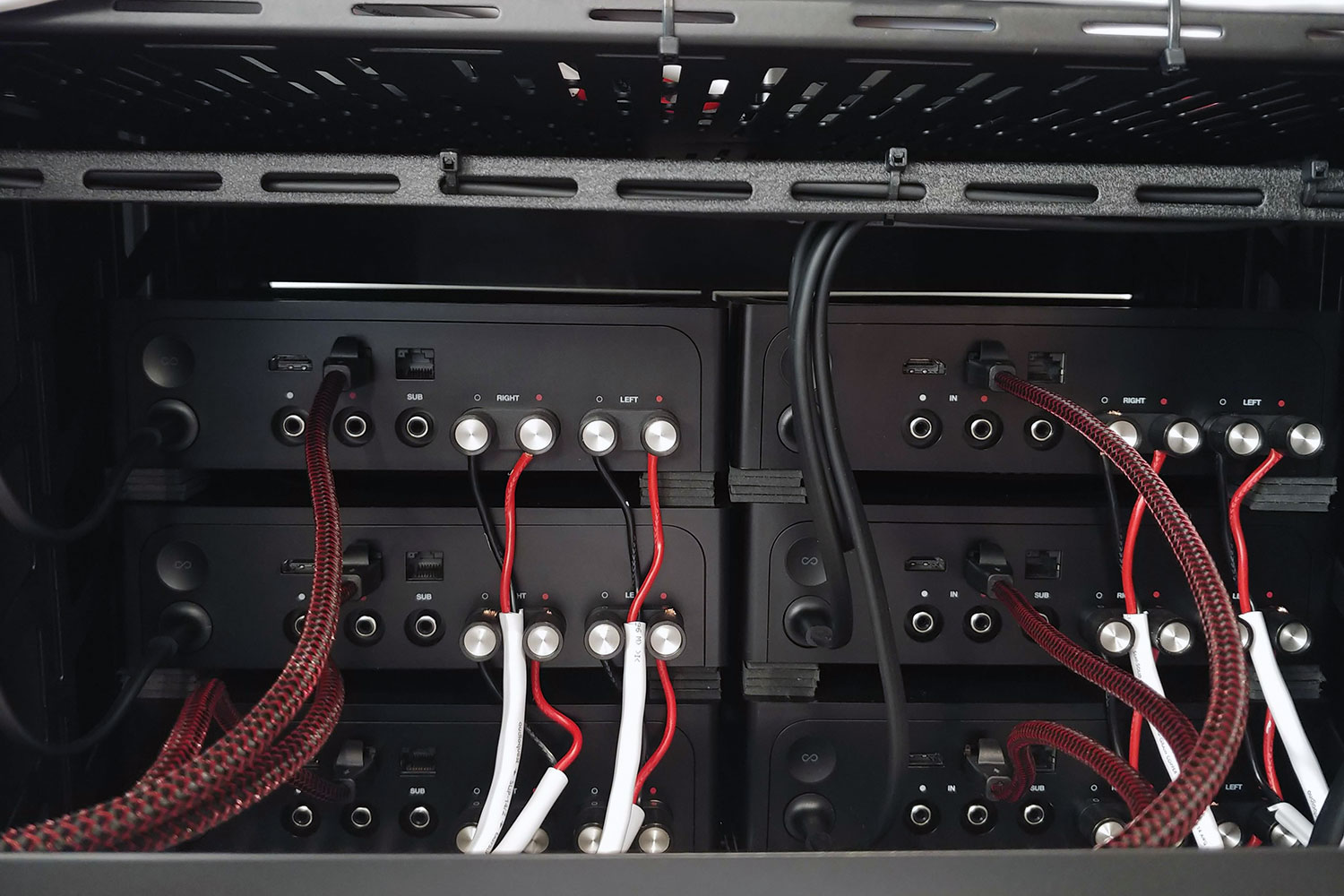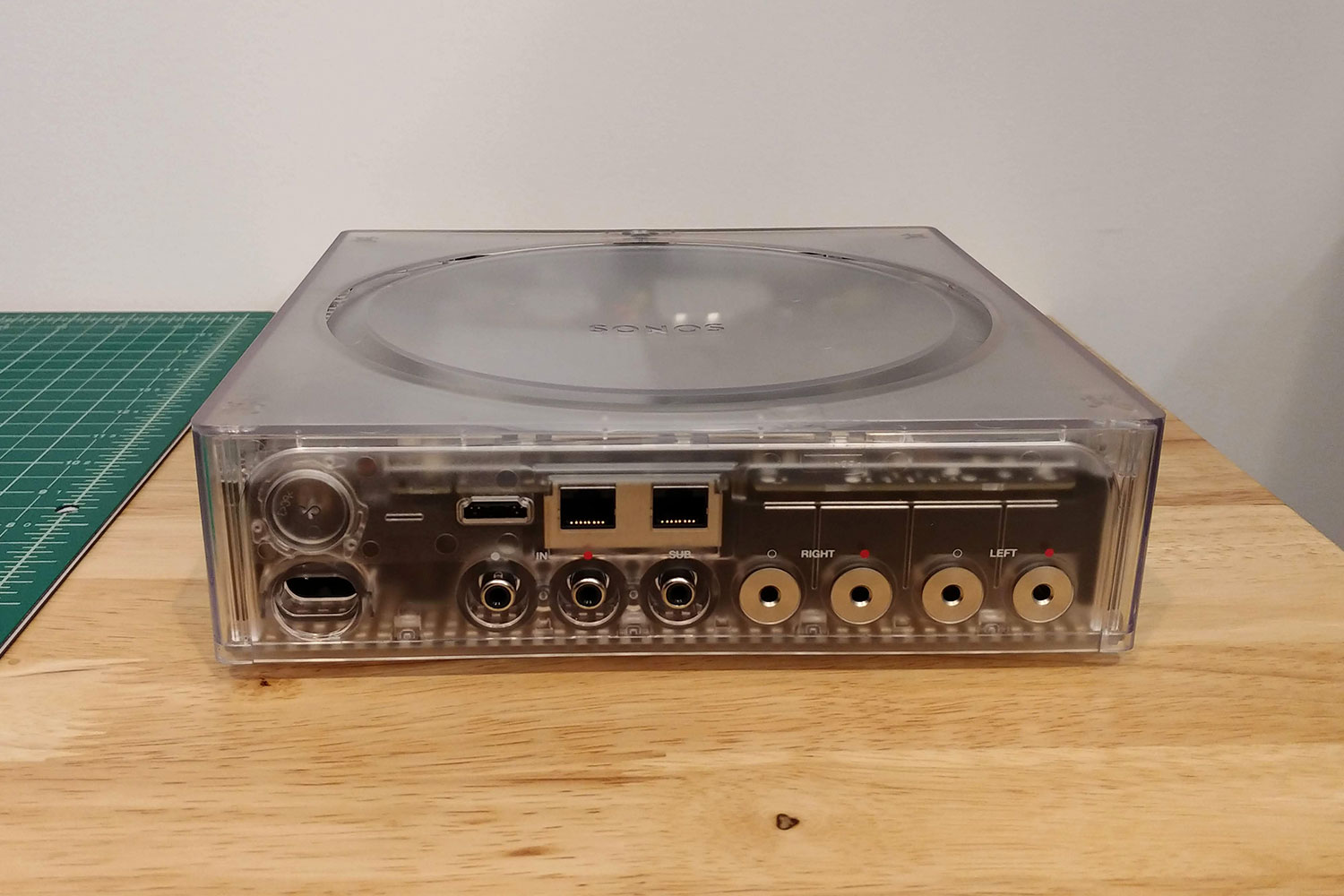Sonos’ multiroom speakers like the Play:1 and Play:5 completely changed the home audio landscape, trading custom installs with wires running throughout the home and closets loaded with twinkling lights for an intuitive, app-based speaker setup that needs only your Wi-Fi to work.
But long before Sonos wireless speakers revolutionized multiroom audio, the company had already revolutionized the custom-install market with its ZP100 Connect amplifier (released in 2005 — we wrote about the successor, the ZP120, back in 2009). That product used the brand’s unique software to not only connect wired speakers to your network, but also to let custom installers create complex multiroom sound systems throughout the home. Today, August 29, the company gets back to its roots.
At a clandestine press event in Boston, Sonos pulled the wrapping off its latest product, a “direct descendant” of the ZP100 Connect in the form of a two-channel amplifier with a whole new bag of tricks. Available in February for $599, Sonos calls its new device simply Amp.
Little black box
Carved into a chic black block in Sonos’ signature minimalist style, Amp’s primary purpose is to be sold directly to dealers and installers as a rack-mountable piece of hardware. But like the original ZP100, it can also be placed on your mantle or TV console (or inside it) as a stand-alone network amplifier to power your living room — this is Sonos we’re talking about, after all.
Amp offers a basic but useful assortment of connections, including a subwoofer output, an RCA analog connection for a turntable or other analog source, AirPlay 2 support for iOS devices, and ARC HDMI connection to interface with your TV. Speaker terminals with banana cables allow you to connect a stereo pair of traditional speakers, with the ability to create a 4.1 surround system via a mix of wired speakers and Sonos smart speakers (the system filters center-channel info from a 5.1 surround system into the left and right channels).
Amp is Carved into a chic black block in Sonos’ signature minimalist style.
All of this is integrated with Sonos’ app-based controller, of course, allowing for grouping with other Amps or Sonos speakers for multiroom playback, as well as streaming from virtually any streaming service or storage drive. On-device controls like pause/play, volume, and a “join” button allow you to control basic functions, create groups, and initiate Wi-Fi connection without the app, as well.
If you add in a smart speaker for voice control (and if you don’t want to pony up for a $200 Sonos One, a $40 Echo Dot could do the trick), the power of Alexa could also allow for voice control of basic functions. The functions we’re talking about include hands-free TV power and volume control, along with other smart speaker functions. And Google Assistant — expected to be integrated into Sonos’ software by the end of the year — will add another font of options for a versatile smart-home setup.
But combine Amp with other custom-installation hardware/software systems and it’s primed to do a whole lot more.
What’s old is new again
It may seem odd for a company that all but single-handedly pioneered a way to replace custom speaker installations with its wireless speaker lineup to get right back into the custom-install game all these years later. But in a lot of ways, it makes perfect sense.

With the rise of the smart home, custom installation has never been hotter, with companies like Control4 and Savant crafting comprehensive solutions that allow you to control just about everything in your home — from your security system to your sprinklers to your entire home theater — all from a simple app and tablet. And Sonos wants a bigger piece of the action.
Upgrades to Amp, like its ARC-HDMI connection with CEC (Consumer Electronics Control) and a wrap-around IR repeater that sends remote-control info, make the device much more versatile for home installations than Sonos’ previous amplifier. And a plan to open the Sonos software API to developers in September could be the key to unlocking all sorts of new applications, including integration with a horde of smart-home devices, from smart lights and door locks to custom components that allow for control over an entire smart home.
More powerful, more versatile
To upgrade its network amplifier, Sonos did its research, honing in on everything people loved about the ZP100 Connect and, more important, everything they hated.
For starters, Amp is more than twice as powerful as its predecessor, offering Class D amplification with up to 125 watts per channel for an 8-ohm load (with power stable at 4 ohms), allowing Amp to power virtually any speakers in your collection, from bookshelves to floorstanders. We heard the system connected to a pair of Bowers and Wilkins 702 S2 speakers, and it had no trouble ramping them up to full throttle.
To load so much power into such a small amplifier, Sonos engineers had to get creative.
To load that much power into such a small package – the unit measures just 8.54 × 8.54 × 2.52 inches — Amp product manager Benji Rappoport says Sonos engineers had to get creative. The more power an amplifier produces, the hotter it gets, which can be especially problematic when you’re using multiple units for massive speaker installations.
Rappoport says a breakthrough moment came when design engineers realized Amp’s inner chassis could also serve as its heat sink, with openings in the circular topside designed to let heat escape. That said, multi-unit rack setups (Sonos software can incorporate up to 32 Amps grouped together) will still need fans for cooling.
Amp’s new ARC HDMI connection allows for higher quality, more accurate TV audio, accounting for lip-sync issues incurred by the ZP100 — which Sonos claims was never designed for TV connection in the first place. Amp also offers dual Ethernet ports for connection to LAN 10/100 speeds alongside Wi-Fi connection (which can also be disabled if desired), as well as an adjustable crossover (50Hz to 115Hz) for the subwoofer output as opposed to the previously fixed 80Hz crossover point.
Smarter software, new partners
As mentioned, Sonos is also upgrading the software side of things to bring new functionality to Amp (and all Sonos hardware). Current upgrades include a dual mono setting in the Sonos app, allowing Amp to power multiple mono speakers where a stereo pair isn’t available, so you don’t get stuck hearing half the sound, as well as features like volume limiting and volume passthrough to allow the app to potentially control other audio devices. And that’s just the tip of the smart-home iceberg.

Sonos expects the opening of its cloud-based control API in September to unleash a swell of new features and functions. Integration of If This Then That (IFTTT) software will allow even novice partners to crack into the Sonos code and create custom applications.
With the introduction of sound notifications to Sonos software, for instance, programmers could potentially integrate sound alerts from smart-home setups like security systems, smart locks, and even geofencing systems, which could do everything from starting your favorite playlist when you walk in the door to announcing your presence to the family before you even park your car in the driveway.
A plan to open the Sonos software API to developers could be the key to unlocking all sorts of new features.
New partnerships with smart-home companies like Crestron, Control4, Savant, and others are designed to help Sonos integrate its software into more complex smart-home systems for even more options. In addition, Sonos announced an intriguing new speaker partnership with custom speaker maker Sonance (no direct relation) for a new custom lineup of outdoor, in-wall, and in-ceiling wired speakers, the latter two categories of which will utilize Sonos’ TruePlay speaker tuning software for tailored sound in any acoustic environment.
The company that pioneered the whole-home wireless speaker segment is no longer content to peddle its speakers and soundbars to the masses. With its latest device and its new open-ended software, Sonos is eyeing a bigger piece of the new smart-home revolution.
The Sonos Amp goes on sale in February for $599, with dealer access beginning December 1.
Update: Updated to clarify that the Sonance outdoor speakers will not utilize TruePlay.











